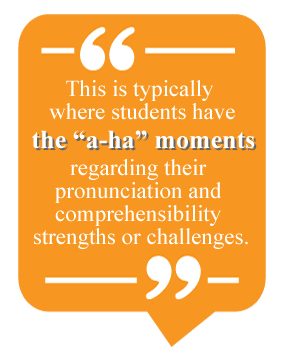
As teachers, we want students to grow in autonomy and self-awareness. One aspect of self-awareness—mindfulness—is positively impacting a number of disciplines, including education and language learning. Ellen Langer, Harvard professor and best-selling author of Mindfulness, defines mindfulness as “the process of actively noticing new things [emphasis added], relinquishing preconceived mindsets, and then acting on the new observations [emphasis added]” (Feinberg, 2010).
Mindfulness and Language Learning
Mindful language learning is a task-based approach that “[recognizes] the need to apply learner knowledge to some task [emphasis added] in order to promote a more complete integration of systematic knowledge and to improve retention of that knowledge [emphasis added]” (Houston & Turner, 2007). The goal of mindful learning goes beyond simply acquiring knowledge; it enables students to see the “language world” from their own perspectives, make observations about their skills, and empower them to act on their own conclusions (Houston & Turner, 2007). Another goal centers on encouraging students to rely on themselves, not just on experts, as they determine their own desirable outcomes from tasks (Houston & Turner, 2007).

How do we integrate mindful learning, empowering students to apply knowledge and improve retention? To move in this direction, I took a presentation in my advanced speaking/listening class and created a multilayered project in which students observe their own presentation, grammar, and pronunciation skills and act on their observations.
Presentation Self-Awareness
Scaffolding
Throughout the semester, students spend time focusing on presentation skills. When they begin the persuasive speech, they should have already given at least one informative speech in class. As a result, they have had some previous presentation practice and are accustomed to giving each other feedback based on criteria you have provided.
Project Description
Students describe a problem or issue they have read about, observed, or encountered related to their programs or American culture, or about their university. After developing the problem, they provide a practical solution in a video-recorded, 7- to 9-minute speech. Students upload it to Box (www.box.com) and view their own speeches in order to provide themselves with evaluative feedback. To do so, students create a 4- to 5-minute video recording, which is a summary of their feedback about the structure/organization of their speech, their performance, their language skills, and an overall assessment. They conclude with suggestions that they would like to keep in mind for future presentations.
Goal and Assessment
The purpose is for students to practice giving a video-recorded persuasive speech and then assess their own presentation by reviewing their own recordings, detailing what skills or behavior they would like to retain or change in the future.
For evaluations, you should watch their persuasive speeches and assess them based on a rubric used for all of their speeches/presentations. Also, evaluate their self-awareness videos, looking for thoughtful comments regarding what students noticed or learned about themselves and how this awareness will inform their future presentations.
Grammar Self-Awareness
Scaffolding
The next piece of this project centers on students’ spoken grammar. At the beginning of the semester, students practice transcribing and analyzing a recorded speech segment: First, they listen to a short segment and individually transcribe it. Afterward, working alone, they analyze their transcription, identifying and correcting errors they noticed. Finally, with a partner, they compare their transcriptions and analyses before they are discussed in class.
Students also have the opportunity to deepen their practice within small groups: A peer from each group is randomly selected to give a two minute impromptu “talk” on a topic. Students record and then transcribe it individually, identifying and correcting grammar and vocabulary errors. As a group, they come to consensus on the errors and corrections and together fill out a simple identification chart.
Project Description
At this point, students are fairly comfortable with transcribing and analyzing speech for errors. Using their persuasive speech recordings, ask them to transcribe a 2-minute selection of the introduction/body and a 2-minute selection of the body/conclusion. After transcribing both segments, they identify and correct errors using an error identification and correction chart. Finally, they re-record those segments, free of the grammar and vocabulary errors they identified in their analyses.
Goal and Assessment
The purpose is for students to actively notice the frequent grammar and vocabulary errors in their spoken English and grow in their ability to self-monitor and self-correct.

To evaluate, look for their ability to determine mistakes in their speaking and ability to self-correct. Assess how thorough they are in their transcriptions, and write in any errors they might have overlooked. As well, evaluate their error identification and correction charts for accuracy and completeness, especially looking for students’ thoughtful awareness of their spoken grammar mistakes and whether they have internal knowledge or access to external information to know how to self-correct. Finally, listen to their re-recordings to assess their ability to mindfully correct the mistakes they initially observed.
Pronunciation Self-Awareness
Scaffolding
Students are learning about and practicing pronunciation skills, including word stress, reduction, thought groups and phrasal stress, linking, intonation, and vowel and consonant sounds throughout the semester. They also study discourse markers and their meanings and purposes.
Project Description
The pronunciation self-awareness project includes students choosing one of the transcriptions already completed in their grammar and vocabulary analysis. Before they listen to their recordings, ask them to mark the following on a clean copy of their transcription:
- Thought groups
- Phrasal stress
- Intonation patterns
- Places where they think they should link
- Places where they think they should reduce
Next, they listen to that segment of their persuasive speech and mark what they actually hear with a different color of ink. Finally, ask them to listen again and note any discourse markers.
Goal and Assessment
The goal is for students to apply what has been studied and practiced as a class to their own pronunciation and to actively notice areas where they are already fairly comprehensible or may wish to focus on for improvement.
Evaluate this by meeting with students individually during class time. First, ask them what they learned about their pronunciation skills—anything they are doing well and/or anything they think they should change. Next, go over their marked-up transcriptions in detail and compare both sets of markings. This is typically where students have the “a-ha” moments regarding their pronunciation and comprehensibility strengths or challenges. Finally, have students speak that segment of their presentation “live” while providing them with individualized feedback.
Teacher Reflection and Student Feedback
This project is a wonderful opportunity for students to grow in awareness of their presentation, grammar, and pronunciation skills. Instead of relying solely on teacher feedback, students actively assess and monitor areas they would like to focus on or change.
To avoid overwhelming students, do not present all the pieces of this project at once. Instead, list the pieces on the syllabus as separate projects due at various times throughout the semester. Provide plenty of input, scaffolding, and practice beforehand. As well, give students time in class to work on their projects in case they have questions or want teacher input or feedback on some aspects of their work.
Students may feel nervous because they have never watched themselves give a presentation. Afterward, however, students often articulate how much they benefitted from this self-assessment. They never noticed, for example, that they frequently touch their noses or use so many fillers. Sometimes the feedback their peers and teacher provide them after in-class presentations is not always remembered or acted upon, but when students notice something for themselves, this awareness seems to make its mark and motivate them to change.
Students also seem to grow in their awareness of spoken grammatical errors. Through this project, they typically have a good sense of what their top spoken grammar (or vocabulary) errors are and how to correct them. In future speaking situations, students seem to be mindful of these errors, often unintrusively self-correcting in the middle of their spoken discourse.
I really enjoy it when students become aware of something without my feedback. After completing her pronunciation self-awareness project, one student told me she was pausing in the wrong places—in the middle of thought groups instead of between them. As a result, she felt like her speaking was halted and unnatural, making it more difficult for people to understand her without some effort. I loved that she became mindful of this issue on her own and wanted to intentionally fix this in order to reach her comprehensibility goals.
I believe this integrated project provides a practical way for students to integrate mindful language learning as they become aware of their own strengths and weaknesses in ways that involve their real speech. Students are also given the opportunity to determine desirable language outcomes for themselves based on their self-assessments and to find their own sense of meaning as they grow in their language abilities. As Houston and Turner (2007) write, “Mindfulness asks students to see for themselves, personally determine how to use their knowledge or skills, and determine what a meaningful outcome is.” A mindful approach to language learning is a beneficial approach for helping students to practically use and retain their knowledge in self-empowering ways.
NOTE: A version of this article first appeared in the February 2017 issue of TESOL’s Speech, Pronunciation, and Listening Interest Section newsletter, As We Speak.
References
Feinberg, C. (2010, September-October). The mindfulness chronicles. Harvard Magazine. Retrieved from http://harvardmagazine.com/2010/09/the-mindfulness-chronicles
Houston, T., & Turner, P. K. (2007). Mindful learning and second language acquisition. Academic Exchange Quarterly, 11(1). Retrieved from https://www.questia.com/read/1G1-165912649/mindful-learning-and-second-language-acquisition
|
Download this article (PDF) |
Julie George teaches in the Intensive English Communication Program at Penn State University. She has extensive teaching experience in graduate/undergraduate writing, spelling, grammar, ITA classes, speaking/listening classes, and adult ESOL.